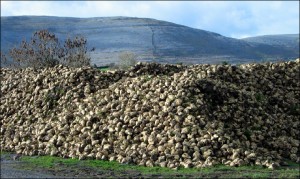
A Fargo-based energy company is moving forward with plans for the nation’s first-ever beet ethanol plant – the first step in an ambitious plan to turn one of the Red River Valley’s top crops into a biofuel mainstay.
A Fargo-based energy company is moving forward with plans for the nation’s first-ever beet ethanol plant – the first step in an ambitious plan to turn one of the Red River Valley’s top crops into a biofuel mainstay.
The proposed plant was announced Monday by Green Vision Group, which touts beets as a cleaner, more efficient alternative to corn, which dominates current ethanol production. Lloyd Anderson, one of the Green Vision partners, said the company hopes to have a pilot beet ethanol plant up and running by 2012.
That plant would be a small-scale operation meant to demonstrate the viability of the ethanol beet technology and business model. It’s being developed in conjunction with an ethanol producer. Anderson did not identify the partner company or the planned site.
The test plant is expected to cost about $5 million. Green Vision Group is seeking money from the North Dakota Legislature. Eventually, the company plans to build a dozen larger production plants, with each expected to cost about $43 million. Commercial production of ethanol beets could start by late 2013 or early 2014.
The company hopes to produce 240 million gallons of ethanol per year. The state now has the capacity to produce about 350 million gallons of corn ethanol a year – about 2.5 percent of the nation’s ethanol production.
To reach those production levels, Green Vision’s plan calls for about 360,000 acres of energy beets, which are modified sugar beets grown specifically for fuel production rather than sugar. Green Vision Group president Maynard Helgaas said those acres might come from a combination of underdeveloped land and land that’s now being used by corn or other crops. Sugar beets accounted for about 220,000 acres in the state this year, while corn accounted for about 2 million acres.
Helgaas said focusing on beet ethanol makes sense for a number of reasons. Green Vision’s figures show that beets produce twice as much ethanol per acre as corn and require about 40 percent less water per gallon of ethanol produced. Using beets instead of corn also sidesteps the controversy associated with using a food product for fuel.
“This is probably the most efficient use for an acre of land for biofuel as there is,” Helgaas said.
Ultimately, the company hopes beet ethanol will qualify as an advanced biofuel – a fuel that cuts baseline carbon emissions by at least 50 percent. That would position the industry to capitalize on escalating Environmental Protection Agency standards that call for producing tens of billions of gallons of advanced biofuel a year by 2022.
The four partners in Green Vision Group – Anderson, Helgaas, Rudy Radke and Rod Holth – all have backgrounds in North Dakota agribusiness. The company is working with Heartland Renewable Energy, an Iowa company that developed much of the technology for the beet test plant. That includes a waste recycling system expected to provide about 70 percent of the plant’s power by burning beet waste. The ash can also be used as beet fertilizer.
Heartland president Rick Whittaker said he realized some time ago that corn wasn’t the most efficient candidate for ethanol. As he explored alternatives, he said, “It was clear to us the best bang for your buck was with beets.”
Whittaker said he wound up working with a North Dakota company because Iowa’s corn-growing establishment wasn’t receptive to his pro-beet mantra.
A similar conflict here doesn’t appear to be in the offing. Tom Lilja, executive director of the North Dakota Corn Grower’s Association, said the state’s corn growers hope “anybody that can make a profit in agriculture” finds a way to do so.
“We certainly hope they can make it work,” he said.

